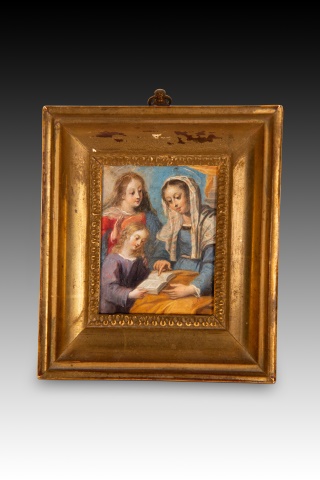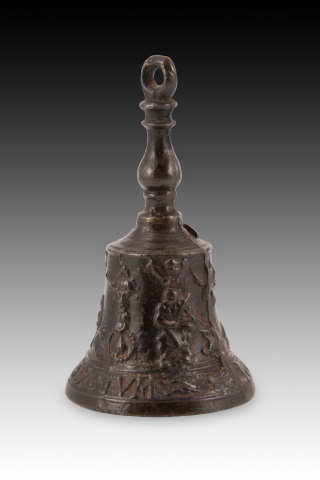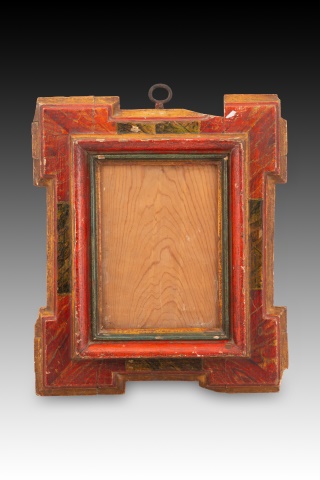
-
Horse and dogs with pages, relief. Moulded and polychrome alabaster. 20th century, based on the model of MANTEGNA, Andrea (ca. 1431-1506). Relief with a frame decorated with elements of classicist influence (mouldings, candelieri…) made of marble powder with polychromy. It shows a figurative scene: a richly caparisoned horse, with a page, and two large dogs with another male figure. Aesthetically, it is inspired by a fresco by Andrea Mantegna, located on the west wall of the Chamber of the Spouses of the Ducal Palace of Mantua (Italy), painted between 1465 and 1474. Weight: 30 kg.
· Size: 99,5x10x157 cms
DECORATIVE ANTIQUES
Ref.: ZE408
-
Pair of fork locks. Wrought iron. Spanish school, 17th century. Pair of wrought iron table fasteners of the type known as “fork” due to their shape. They are decorated with scrolls and a section of the iron torso, as well as a balustrade shape each and a small disc, following Spanish Baroque models. Weight: 4.5 kg.
· Size: 26x18x95 cms.
DECORATIVE ANTIQUES
Ref.: Z0205C
-
“Armurier”. Patinated metal. Attributed to Mage. France, 19th century. The male figure, with a powerful posture and musculature without exaggeration, is holding the tools of his trade next to an anvil, at whose feet appear an ancient helmet and sword. On the small pedestal decorated with plant elements there is a metal plaque with the title (“Armurier” – Armorer) and the surname of the author (Mage).
· Size: 25x25x70 cms.
DECORATIVE ANTIQUES
Ref.: ZF0271
-
Peace-bearer. Bronze. 16th century. Peace-holder made of bronze with a flat handle on the back and a slightly raised decoration on the front. Beneath a crown of openwork plant elements in a clear Renaissance style, there is an architectural composition with columns framing a figure of Christ sitting on a throne.
· Size: 7,5x3x10,5 cms
ANTIQUES
MISCELLANEOUS;OTHER OBJECTS
Ref.: ZF0538
-
Pair of door knockers. Iron. 20th century. Pair of knockers made of iron, with one piece for fixing to a door and another, joined by a hinge, for knocking. The second one is shaped like a winged monster or dragon, with a long neck, a tail coiled in the shape of a snake, two front legs holding orbs and a long neck ending in a head with open jaws and a visible tongue. Both pieces are inspired by old European examples.
· Size: 29x10x23 cms.
DECORATIVE ANTIQUES
Ref.: ZF0786
-
Bullfighting scene. Oil on canvas. Signed (bottom left corner). GONZÁLEZ MARCOS, Ángel (Madrid, 1900 – 1978). A master of impressionist painting, Ángel González focused on bullfighting from his youth. He portrayed these themes from a tragic point of view, the drama starring the bull, the absolute starting point, and not the bullfighter. His work captures the rhythm of the movements of man and animal, the different phases of the bullfight, the energy, the liveliness and the colour with great immediacy and dynamism, reflecting bullfighting in all its splendour, without ever forgetting the expressive function of the bull and the bullfighter. He exhibited in Spain, Mexico and Peru, and is currently represented in various museums in Spain, as well as in New York, Lima, Bogotá, Caracas, Paris, Lisbon, Rio de Janeiro, Tokyo and Rome.
· Size: 63x5x44 cms. int 56x26
DECORATIVE ANTIQUES
Ref.: ZF0847
-
Cupid. Enameled porcelain. Possibly Meissen, 19th century. With sticker on the base. Has restorations. Porcelain figurine with an oval, gilded base on which Cupid is shown lying down, characterised as usual by his wings, bow and quiver of arrows. He also carries a torch and is shown with a garland of leaves. The piece bears strong similarities to figures found on Meissen clocks dating from the 19th century. VL Veneziani was a shop with its main office on Via Frattina in Rome (and another shop on Via Gregoriana) specialising in selling antique and antique-style paintings, furniture and porcelain. Works related to this trade are held in various private collections and in the Fondazione Federico Zeri of the University of Bologna.
· Size: 19x13x20 cms. s/base: 19x12x17 cms
ANTIQUES
Ref.: ZF0910
-
Pair of vases. Bronze, marble. 19th century. Pair of vases made of carved light marble with a stepped and circular base of the same material, which also have decorative details in gilded bronze (chains of pearls, necks with architectural elements, etc.), with a clear classicist influence. This type of work was common in Europe during the 19th century, with the strong French influence of the pieces also being very common.
· Size: 10,5x10,5x27,5 cms.
ANTIQUES
MISCELLANEOUS;OTHER OBJECTS
Ref.: ZF1004
-
Inkwell. Glazed ceramic. Talavera de la Reina, Spain, 17th century. A square-shaped inkwell or spice rack made of glazed ceramic with a polychrome decoration of plant elements on the top and fronts. Due to the colours used, it belongs to the so-called tricolour series, which began to be produced in Talavera de la Reina at the beginning of the 16th century and became common even at the beginning of the 18th century. Compare this with the decorations on pieces kept in the Museo Nacional de Artes Decorativas (Madrid, Spain), or in the Museo de Cerámica Ruiz de Luna in Talavera de la Reina (Toledo, Spain).
· Size: 9x9x5.5 cms
ANTIQUES
Ref.: ZF1047
-
Botijos, Don Quixote and Sancho Panza. Ceramics. Spain, 20th century. Pair of jugs made of glazed ceramic in brown tones, with inscriptions and drawings in a lighter tone, showing the well-known characters Don Quixote and Sancho Panza, from the novel by Miguel de Cervantes Saavedra, Don Quixote de la Mancha, published in its first part in 1605 with the title El ingenioso hidalgo don Quijote de la Mancha, and the sequel in 1615. Weight: 37 kg.
· Size: Quijote: 33x33x92 cms / Sancho: 35x36x78 cms
DECORATIVE ANTIQUES
Ref.: ZF1135
-
Travel clock with case. Metal, glass, leather, etc. 19th century. Travel clock with a lid on the top and a transparent glass front, lined on the inside, containing a travel clock with alarm function. It has a handle and a decoration in two bands of plant elements, four legs, transparent glass fronts, a small glass window on the top, and a door on the back. The dial is white, with Arabic numerals for the hours and dots for the minutes, and it has another small second hand dial below the first one. Around the dials there is a composition with a bird and a butterfly with plant elements in gold metal. Weight: 1.25 kg.
· Size: 10x8.5x13.5 cms
DECORATIVE ANTIQUES
Ref.: ZF1148
-
Sold

Saint Anne teaching the Virgin to read. Oil on copper. Spanish school, 18th century. Small copper depicting Saint Anne seated, with a book on her knees, and accompanied by the Virgin Mary as a child and an angel at her side. In the background we can see a fragment of curtains and a bit of architecture. Both iconographically and stylistically, this is a frequent theme in Christian European art, with some Italian influence and a composition common in works from the Spanish school.
· Size: 10,5x2,5x11,5 / int: 6,5 x 7,5 cms.
ANTIQUES
Ref.: ZF1294
-

Hand bell or bell, “from Malinas”. Bronze. 16th century. Hand bell with clapper made of bronze and decorated on the outside with a slight relief. The base has, between bands, an inscription in capital letters and in Latin (“Sit nomen Domini benedictum”, “Blessed be the name of the Lord!”); above it, on the body of the bell, there is a decoration with angels, vases with plant elements, garlands, a figure playing a musical instrument, etc., with a great classical influence; the hand has a balustrade shape with mouldings. The text refers to the Apostolic or Papal Blessing, typical of Catholic liturgy. The export trade of handicrafts and artistic pieces during the 15th and 16th centuries that took place in the Netherlands was of great importance, especially between the territories that were then united under the same crown. Among the pieces (experts speak of almost industrial production) that enjoyed the greatest diffusion were these bells called "de Malinas" because they came from this Flemish city. The success of the model is indisputable and proof of this is that, from imported examples, molds were made with which to obtain absolutely identical copies. These bells usually have common characteristics such as their small size and their beveled profile; however, the peculiarity that easily identifies them is the decoration they have on their surface. Weight: 425 grams.
· Size: 8x8x14 cms.
ANTIQUES
Ref.: ZF1302
-
Sold

Frame. Carved and polychrome wood. 17th century. It has faults. Rectangular frame with smooth mouldings of different widths and tones on the inside and a flat area on the outside, stepped outwards and with right-angled widenings at the corners. Note the polychromy it presents, reminiscent of marbling. On the back, it has a metal piece to place it on the wall.
· Size: 29,5x5x34,5 cms. int:20x15 cms
ANTIQUES
Ref.: ZF1359
-
Young man in a tunic. Carved and polychrome wood. Spanish school, 14th century. Figurative carving made of wood that still preserves traces of polychromy and gilding. It would probably be a young man (without a beard and uncovered hair), with an object in his hand (perhaps a book). As there are no other elements, a sure identification of the figure is not possible (it could be an Evangelist). The shape and aesthetics of the piece would place it within the Spanish school, dating it to the 14th century.
· Size: 12x7x33 cms
DECORATIVE ANTIQUES
Ref.: ZF1372
-
Spice rack. Silver. Spain, 20th century. With contrast marks. Oval-shaped vessel supported by four legs with a human head, extended wings and an architectural base with vegetal decoration with a marked classicist taste. Stylistically, it is inspired by old models of Spanish silverware. You can see the star reserved for First Law silver in the 1935 Regulation, and a silversmith's mark that has not been identified.
· Size: 12,5x11x11,5 cms
DECORATIVE ANTIQUES
Ref.: ZF1375
-
Oinochoe. Bronze. Possibly Italy, 19th century. An oenochoe, oinochoe, oinochoe or oenochoe is a vessel used to draw wine from a krater (where it was stored) before serving in ancient Greece. Its heyday was during the Geometric period and various types are distinguished according to the shape of the mouth and the belly. Most Greek oenochoes were made of terracotta, but there are also some made of precious metals, presumably for the social classes that could afford them, although very few have survived. The present example seems to be inspired by ancient works (compare one in the Metropolitan Museum from around 460 BC with inventory number 1970.11.1 and another in the Museum of Fine Arts, Budapest with inventory number 66.142.A).
· Size: 12x12x20 cms
ANTIQUES
Ref.: ZF1390
-
Peace-bearer. Bronze. 16th century. Bronze peace-bearer with a flat “C” handle on the back, with a relief decoration on the front framed in a classical architectural composition common in the Renaissance. Below the columns on the sides there are two heraldic shields (without a bonnet, cords with tassels on three levels) with a Latin cross in the middle area; the centre shows a Birth of Christ under a domed cupola with winged angel heads in the corners; at the top and under a semicircular arch, there is the bust of Santo Domingo de la Calzada, facing forward, with an inscription in capital letters.
· Size: 10,5x5x15,5 cms.
ANTIQUES
MISCELLANEOUS;OTHER OBJECTS
Ref.: ZF0543A
-
Wireless Set No. 19, MK II. Canada, ca. 1942. Wireless Set No. 19, commonly known as the Wireless Set No. 19, was a mobile radio transceiver used in World War II by the British and American armies. Designed for use in tanks and armoured vehicles, it was developed in 1940 by the British War Office's and Pye Radio, the Pye model being superseded by the Mk II in 1940 and this by the Mk III in 1942. In 1942, the No. 19 Mk II was produced in Canada, improving on the British design (most Canadian sets used English or Cyrillic lettering on the front panel, the result of a contract with the Soviet Army). Weight 25 KG..
· Size: 29x44x38 cms.
DECORATIVE ANTIQUES
Ref.: ZF0737B
-
Vegetable bowl with lid, Morro Castle, Havana, Cuba. Earthenware. Sargadelos, 19th century. It has minor flaws. Vegetable bowl with handles and a lid on which a landscape can be seen, identified with a text (Morro Castle, Havana, Cuba), enhanced by a border that extends over the edge and continues (but in relief, not in pigmentation) along the handles of the piece; the base also has decoration. The lid has a flower in relief as a finish and a series of decorative borders in a tone matching the rest of the piece. Antonio Raimundo Ibáñez, Marquis of Sargadelos, founded the Royal Pottery Factory of Sargadelos in Cervo, province of Lugo, at the beginning of the 19th century. The view of this piece belongs to the Series of Views of Cuba, used in the factory since 1848.
· Size: 34x26x18 cms
ANTIQUES
Ref.: ZF1370A
-
“Rural scene”. Oil on canvas. Signed (bottom left corner). LÓPEZ MURIAS, Isidro (Tetouan, Morocco, 1939). Isidro López Murias trained at the School of Arts and Crafts in Palencia and the Faculty of Fine Arts in Madrid, earning his first distinctions in 1953 and 1954. He has exhibited his work in Pamplona, Palencia, Santander, Burgos, Valladolid, Madrid, Ávila, Segovia, Murcia, New York, Barcelona, Bilbao, San Sebastián, etc.; and it can be found in numerous private collections (Spain, France, Italy, etc.) and in various institutions (Museum of Navarra, Royal Academy of Fine Arts of San Fernando in Madrid, collection of the Parliament of Navarra, Rodríguez-Acosta Foundation in Granada, etc.).
· Size: 65x4x50 cms.
DECORATIVE ANTIQUES
PAINTINGS
Ref.: Z5820A19
-
Bullfighting poster, Inauguration of the San Sebastian bullring. Oil on canvas. PÉREZ SAAVEDRA, Manuel (doc. Circa 1903). 1903. Original poster for a bullfighting event for the opening bullfight at the San Sebastián bullring (known as Coso de El Chofre), which was attended by Alfonso XIII. It is a work in a clear Modernist style by Manuel Pérez Saavedra, and this was the original poster for the event. There are references to a Manuel Pérez Saavedra in the documents of the Royal Academy of Fine Arts of San Fernando in Madrid of the Provincial Commission of Monuments of Lugo (minutes of the session, 1921), in the Regional Exhibition of Galician Art of 1917 held in La Coruña, in the catalogue (as a native of Madrid) of the General Exhibition of Fine Arts of 1897, etc.
· Size: 52,5x6x85 cms. Int 37x70 cms
ANTIQUES
Ref.: ZF135401
-
"Poster announcing the Bullfight held on the occasion of the marriage of HM King Alfonso XIII to HRH Princess Victoria Eugenie of Battenberg." Framed lithograph. BENLLIURE, Mariano. Spain, 1906. Alfonso XIII can be seen greeting the public from the royal box, accompanied by Victoria Eugenia and a number of figures, below the text, which extends to the right. In the lower area, with ribbons, you can read "Long Live the Queen." The model for this poster was designed by Mariano Benlliure (1862-1947), who already had experience as a bullfighting poster artist. The lithographic artist was Antonio de Ángel Alcoy (circa 1863-1925), and the Litografía Mateu of Madrid was responsible for the production.
· Size: 47x1x68 cms
ANTIQUES
Ref.: ZF135445
-
Display table in lemon-coloured wood. The rectangular display case rests on four cabriolet legs, with glass on all five sides (sides, front and top) framed by fine mouldings in gold metal and a front lock with a key. The interior is upholstered in pink with capitoné.
· Size: 75x45,5x79 cms
DECORATION
FURNITURE;CLASSIC
Ref.: D161